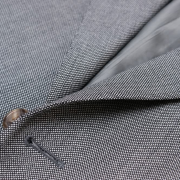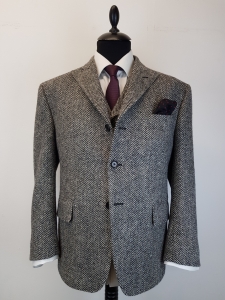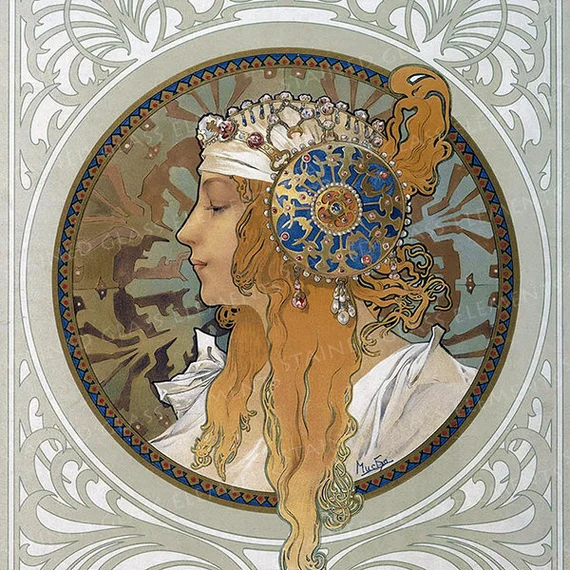We have already spoken at length about the pinstripe and lime stripe, but what about other well-known fabric patterns for a (tailor-made) suit? Apart from the striped suits, there are of course the plain fabrics, which do not need any additional explanation as far as the motif is concerned, because it is not there. But there are other common variants. We discuss the most well-known ones here.
The Glen Plaid, or Prince of Wales (Prince de Galles)

It is (mostly) a woolen fabric, with a woven pattern of overlapping large and small checks. The pattern is best described as 2 dark and 2 light stripes alternating with 4 dark and 4 light stripes.
This gives a diamond pattern of irregular squares. Usually, in the most classic form, a black and white combination of yarns is used, which gives it a grey appearance. In exceptional cases, a red, green or blue yarn is incorporated, which draws a larger but subtle diamond in the pattern.
President Ronald Reagan was considered un-presidential in a grey-blue Glen plaid during a European trip in 1982. And Cary Grant wore the iconic suit in the 1959 American spy-thriller 'North by Northwest'.
The 'Bird's Eye', also called 'œil de perdrix'.

Perfect for formal wear, especially in summer. This is because the fabric can be made very light and therefore has a fine breathability. The cotton variant in particular is perfect for a spring or summer suit.
You can easily clean the fabric with an ordinary clothes brush and some steam to remove the creases. However, you should always hang the suit or jacket on a good hanger, especially the looser varieties, to ensure that the shape is preserved.

The motif consists of broken diamonds, or abstract quadrangular shapes. Classically made in black and white, but also very beautiful in other colours. If one has a very fine small version of the 'houndstooth', it is called a puppy-tooth. The French name is inspired by the imprint of a bird's foot. The method of weaving makes it a very strong fabric.
The pied de poule motif first appeared in the West in the 1930s. In the Netherlands, pied de poule is called hound's-tooth or windmill motif, in England it is called hound's-tooth, cock's-tread or crow's-foot design and in Germany it is called Hahnenschritt.
The motif is introduced during the weaving process by means of a twill weave* in combination with a certain sequence of colours in the warp and weft threads.
Edward VIII of the United Kingdom often wore suits with this motif, which quickly increased its popularity.
Herringbone.
The herringbone pattern dates back to the Roman Empire, where it was used in buildings and roads. This interlocking paving system is built on a base of crushed stone, which cleverly absorbs the pressure of traffic and footsteps, making it extremely stable and durable.
This innovative way of creating roads was revolutionary because cultivating a powerful infrastructure of Roman roads was vital for the preservation and development of the Roman state.
Herringbone can also be traced back to ancient Egyptian jewellery worn by the elite.
However, the earliest herringbone fabrics were found in ancient Italy. How appropriate that herringbone is now an essential fabric used in the making of menswear! This distinctive fabric design also found its way into historic Irish textiles, which were often used in rustic tweed suits.
The herringbone pattern, usually in will, is very popular for suits and "outerwear".
We find the pattern frequently in Tweed, for example.
Just like the English origins of the brands that made it their leitmotif, the tartan, or rather the
sees the beginning of its history in Scotland. The endless combinations of warp and weft of this woollen fabric gave life to the colours of the clans that made up Scottish society in the sixteenth century and to their traditional kilts.
It then became the uniform of official occasions under the reign of King George IV in 1822, but no one could have imagined how far this vicar would go.
The windowpane has gained a lot of popularity in recent years, especially among younger suit wearers.
The big advantage is that the windowpane makes a skinny man look a bit firmer, and the heavier man look a bit slimmer.
The pattern is also very versatile in its combinations, and even if you are colour-blind you can always get away with it. They are usually not perfect squares, but rather rectangles. So they are slightly longer than wide. This enhances the optical effect, by the way.
Raphaël van den Poel, former fashion consultant of Scapa, Reinhard Frans and Atelier NA tailored suits,
writes our weekly blog on gentleman matters. He writes for MYX Magazine, a Flemish luxury lifestyle platform.
He also has his own blog which you can read here: http://belgiandandy.blogspot.com












